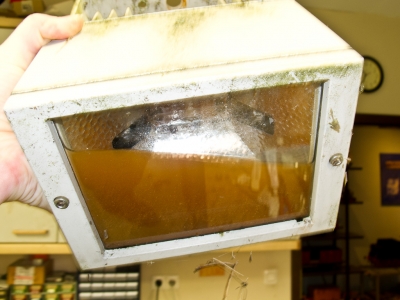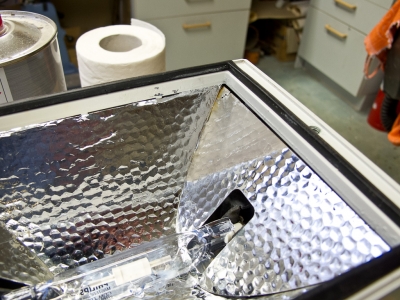Repair instead of new
From the series: you can fix almost anything. Since I am against wasting resources and the throwaway society I prefer repair, even if noone is doing it because it simply takes too long and is thus too expensive. The outdoor lights stopped shining, which was not very surprising given their new function as a underwater spotlight:
Every 'normal' buisinessman would've junked them and bought some new ones, but I'm not normal and quite frugal.
First of all, you strip it down and clean every part. Functionally, the ignitor was done - somehow it only lasts as long as the bulb. The ballast coil cannot be broken, it works just the same with slight rust marks. I replaced the rusted screws with new ones, some new cables, a 3D printed new gasket for the cable gland stopped the fresh water supply. I took NinjaFlex and after one season the seal is still flawless. Then an new bulb and the thing was as good as new. Only the reflector was not so easy to repair: caused by the underwater treatment, it became blind up to the waterline. Of course, there are no spare parts available.
But if you wait a bit, the INTJ also has a solution for that: The reflectors are typically made of shiny aluminum - I've read that in a different context. So you can even fix that: cut some aluminum foil (is also shiny aluminum), spray it with spray adhesive and rub it on - you cannot see the difference. Therefore on the picture: left and center new, right still blind:



Comments
Display comments as Linear | Threaded
An IxTx, not sure yet on :
Is the ignitor the same type as those for fluorescent tubes, or one of those metal cans (maybe there are plastic ones too) that the wires are connected directly to?
If it's the same as for fluorescent tubes, if the lamp goes out and cant be reignited, the ignitor will repeatedly try to ignite it, and if left for long enough, usually hours to days, might be shorter for this type of lamp since it's higher power and thereby higher current than a fluorescent, it will wear out. It's a bimetallic strip in a glass bulb containing inert gas, in this application connected in parallel to the lamp, the higher voltage across the unignited lamp causes a glow discharge which heats the bimetallic strip so that it makes contact with the opposite pole pin in the bulb, short-circuiting the lamp. This connects the inductive ballast across the mains, and when the strip cools, it disconnects - hopefully at the peak of current in the sinewave and thereby stored energy in the inductor - causing a voltage spike that ignites the lamp. The now lower voltage across the lit lamp (usually about half mains voltage), is not enough to re-establish the glow discharge in the igniter, so it doesn't short circuit the lamp and put it out. The bimetallic strip disconnecting is what makes the little "tink" noises when lighting up fluorescent tubes.
If the starter is "part of the fixture", with wires connected by screw terminals or similar, I suppose it uses some clever arrangement with some kind of timing circuits and a power transistor, but I haven't taken any apart or read about them, so I'm not sure. Such a starter not lasting longer than a bulb is obviously bad quality. In this case it might be the water ingress, but I assume that you have more than this example, as I suppose you would have thought that too if this was the only one.
I'm just like you in regard to throwing vs repairing. I mostly do component-level repair on electronics, not professionally but for myself, family and friends. Bad capacitors in switch-mode power supplies are the by far most common problem, and without it, probably 50% of electronics waste would be eliminated.
Stephan Brunker on :
This lamp is Mercury-based and operates with High Voltage, it is not like the simple ones operating with line voltage. And because of that is the electronics package a sealed unit. But as I could find out, the basic problem is the same like you said: The igniter has only a limited number of cycles and after 1.000 oder 2.000 cycles it has reached its end of life. I have similar, just slightly different ones for indoor use and there is basically the same problem. I have like 15 of them for 20 years now, they now have the third bulb each and I also had to replace a couple of the igniters. It just wasn't as bad as the outdoor ones. Or perhaps trying to ignite the faulty bulb over a longer timespan (because I didn't check them regularly) finished the igniter too? It doesn't matter, because that was the part I could get as replacement.
An IxTx, not sure yet on :
Interesting, I've never seen this kind of lamp that uses HV after igniting. Do you know the running voltage?
Anyway, great that they still sell the igniters.
Stephan Brunker on :
I really don't know the voltage. As an INTJ, I am at a "get it running" approach. I just saw the "danger high voltage" sign and the cable with a lot of insulation and that was enough for me to keep my fingers away. And there really was nothing to repair, the igniter was in a sealed case. If you are more into the "how does it work" approach, you are probably an INTP, that is one of the major differences, you can see that in my latest video, for me it simply isn't worth the effort to crack that case open and figure out how it works if I can replace that part for an acceptable cost.